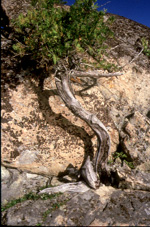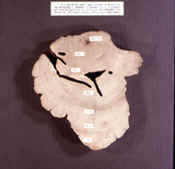Old cedars and dendroclimatology
 |
 |
Even though islands are frequently
affected by fires, a number of islands in Lake Duparquet have managed to remain unburned
for thousands of years. Absence of fires and the presence of slow growing conditions have
allowed certain cedars to attain venerable ages, approaching 1,000 years. Discovery of
these specimens provided a means of reconstructing climate changes over the last 800
years, using fluctuations in radial growth of these old cedars (fire history map; Archambault and Bergeron,
1992). Periods of good growth correspond to hot and
humid conditions, whereas periods of slow growth are
associated with cold and dry conditions. The slow growth
between 1600 and 1850, corresponds to the period known
as the "Little Ice Age" ; a period of
better growth since 1850, is possibly associated with
global warming. This recent warming, associated with
an augmentation in summer precipitation, explains the
marked decrease in fire frequencies during the last
100 years (fig. 1; Bergeron and Archambault, 1993).
Moreover, the presence of the dwarf mistletoe (Arceuthobium pussillum), a parasite of black spruce occurs on
some islands that have not burned for a very long time.

Fig. 1. a) Fire occurence in lake Duparquet
area, b) Burned area on shore perimeter and
c) Burned area on islands, d) Long term change
of white cedar radial growth from lake Duparquet
islands, e) Summary of global deviation to
average temperature for the period 1680-1990
according to the Intergovernmental Expert Group
for the Study of Climate Change.
|

|